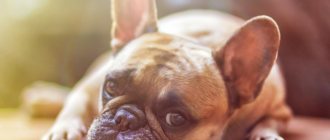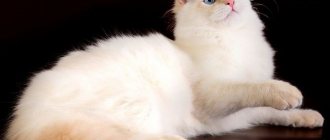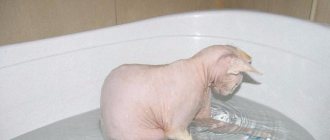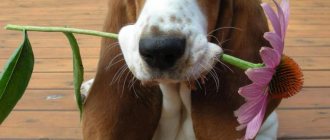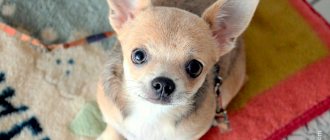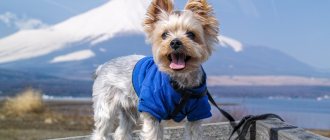Today you won’t surprise anyone with a purring sphinx, but a hairless terrier will definitely attract attention. Dog experts are still arguing about the origin of hairless dog breeds. The most popular version says that these four-legged animals owe their exotic appearance to the hot climate. Their hair, as unnecessary, either disappeared completely or was partially preserved: on the head, tail or paws. Animal fur is a strong irritant, so for people prone to allergies, hairless dogs can be ideal pets.
Hairless dogs “breathe” with their skin: their sweat glands are distributed throughout the body. They don't need to regulate their temperature with their tongues like their furry counterparts do. Grooming hairless dogs is not easy: they are susceptible to cold and scorching sun.
Today, dog experts officially recognize the Chinese Crested Dog, the Peruvian Inca Orchid and the Mexican Hairless Dog. They have an approved international standard, which allows them and their owners to take an active part in various exhibitions. In total, nine breeds can be distinguished today.
Chinese Crested Dog
A very common hairless breed. The “Chinese” can be easily recognized by their stylish hairstyle – a crest. Long fur on the tail and legs is another distinctive feature.
A variety of this breed is the downy “Chinese” with a thick undercoat. Their fur covers their entire body. The shortest pile is at the muzzle. There are also completely naked “Chinese” people.
The crested dog is miniature: its height does not exceed 30 centimeters, its weight is 3-5 kilograms. The color can be black and white, chocolate, marbled and spotted patterns are allowed.
Read The fluffiest dogs - top 20 ranking
Mexican Hairless Dog (or Xoloitzcuintle)
A rare breed native to Mexico. In ancient times, the Xoloitzcuintle was used for medicinal purposes due to its high body temperature (about 40 degrees). Graceful athletes with a high forehead and developed chest are usually completely hairless. It is allowed to have sparse hair on the paws and tail, as well as a small tuft on the head. The skin of such dogs is dense, smooth, and pleasant to the touch. In color, preference is given to dark tones (black and gray), but brighter individuals (red and bronze) are also found.
“Puffs” of these breeds are allowed for breeding, but do not take part in exhibitions. Their body is covered with short, stiff hair.
How did such breeds appear?
Experts suggest that these types of dogs appeared at the dawn of civilization. And the African continent is considered to be their homeland. The lack of wool is explained by the fact that the animals lived in lands where it was always warm or hot. Therefore, they did not need a fur coat. An interesting fact is that the sweat glands of these four-legged animals are located throughout the body, just like in humans. And in dogs with fur they are on the tongue.
Which hairless dogs are officially recognized?
At the moment, only 3 varieties of such dogs are recognized by dog handlers:
- Mexican
- Peruvian
- Chinese Crested.
The rest have no pedigree. They also cannot take part in professional exhibitions. But if you do not plan to win awards with a four-legged dog, then pay attention to other breeds. They also make wonderful pets.
Peruvian hairless dog
A dog with a strong build. They come in small and medium sizes. Also known as the Inca Orchid. Their character combines a little stubbornness and boundless kindness. They are distinguished by great mobility. They are loyal to the owner, but are suspicious of outsiders. Therefore, they make excellent defenders. Ideal for families with children. In addition to the lack of hair, they have another feature - a small number of teeth. Beautiful and graceful dogs. Color - from light gray to black. Sometimes spotted.
Chinese Crested
It got its name thanks to the crest on its head. Compact size dog. Unlike other representatives, they still have fur - on their heads and legs, and a tuft on their tail. The fur is quite long, but does not require grooming or cutting. You need to be careful when keeping crested animals. Temperature changes can make them sick. Ideal for keeping in an apartment, they are easy to train to the tray. Very kind doggies.
Mexican hairless dog
Also known as the Xoloitzcuintle. There are two types - with and without wool. Moreover, one litter can contain both. These dogs must be trained from an early age, as they are prone to dominance. Mexicans are incredibly loyal to their owners. Strangers are treated with suspicion. The dog voices extremely rarely, so you should be wary. Very mobile and active.
Hairless American Terrier
It was bred later than other species - in the 80s of the last century. Its ancestors are rat terriers. The breed is not yet officially recognized as it is still being developed. Dogs have strong immunity and are not prone to various skin diseases. Like all terriers, they have a wonderful character. Cheerful and mischievous, they make excellent companions. They tolerate physical activity very well. Colors are pink-brown with spots of different shades. They can live 15-16 years.
Hairless Deerhound
A variety of Scottish greyhound that was developed through selective breeding. Today you can find them very rarely. The “bald” gene is not dominant and can appear only a month after birth. They have very delicate skin that is susceptible to injury - even while walking.
Manchurian hairless dog
A variety of Chinese Crested. It also has a crest and fur on its legs, tail and head. In character it is very similar to the crested one. Hypoallergenic, odorless. Never catches fleas.
African hairless dog
This is an endangered species. The dogs are considered the progenitors of the Chinese Crested. They have a thin build and thick skin. They have a keen sense of smell. Medium-sized dogs - up to 40 cm. Active animals. They have a spotted color - the main color is dark gray. The spots are white or gray-white. There is a theory that the breed became extinct or assimilated.
Egyptian hairless dog
Originally from Malta. She is also called Pharaonic because of her protruding ears and resemblance to the ancient Egyptian kings. The dogs are not completely hairless - they have hair, but it is very short. Those who decide to get a four-legged dog should know that dogs are not very trainable. You need to spend a lot of time raising them.
Ecuadorian hairless dog
The rarest breed among hairless dogs. They can only be found in hot African villages. Smart and energetic dogs. Life expectancy is 12 years.
How to care for hairless dogs
Such breeds have their own characteristics in care. Their skin is very delicate, so dogs do not tolerate temperature changes well. Owners need to ensure that their pet does not become hypothermic or overheated. To care for their skin, you need to purchase special creams or lotions. You also need clothes that you sometimes need to dress up in your apartment/house, and not just while walking.
There is no need to bathe your pets often, as you can dry out the skin. 1-2 times a month is enough. After bathing procedures, the dog’s skin is lubricated with cosmetic oil.
Another feature of hairless dogs is the presence of fewer teeth. This should be taken into account when eating. Portions should be small. And the food is easy to chew. For example, meat or porridge. Give fruits and vegetables, and vein bones several times a month. This will help develop the jaw.
Peruvian Inca Orchid
“Peruvians” are graceful and elegant, harmoniously built, and the texture of their skin is similar to that of humans. There are two types: naked and “woolen”. In hairless animals, remnants of vegetation can be found on the head, tail and legs. The skin is smooth and elastic, ideally uniform. The presence of white or pink spots is allowed, the area of which should not exceed a third of the total surface of the skin.
Among the woolly “Peruvians” there are three types: short-haired, smooth-haired and long-haired. The latter are extremely rare. The most prized among them are the short-haired smooth Inca orchids.
Rare breeds of hairless dogs
Other types of hairless dogs are extremely rare, and little reliable information is known about them:
The African Hairless Dog is a museum exhibit.
- Abyssinian sand terrier. The second name is African Hairless Dog. The breed is registered by only one canine organization - the Continental Kennel Club. Some dog handlers consider it lost. According to other sources, Abyssinian terriers are still bred in the Cape Province in southern Africa.
- Manchurian Hairless Dog. The animals are found in the mountainous regions of China under the name "tai-tai". In appearance and character they resemble Chinese crested cats. Local residents get funny, active dogs “for the soul” and for children’s entertainment.
- Ecuado?
American Hairless Terrier
Active dogs with well-developed muscles and a beautiful physique. The breed was officially recognized in our country more than ten years ago, when the “Americans” received the right to participate in Russian exhibitions.
A distinctive feature of the American Terrier is its minimal coat (maximum millimeter). Puppies of this breed are born fluffy. At the age of two months, the cover almost completely disappears. Small patches of fur may remain only on the face. The skin of such dogs is soft and delicate. As for color, many options are allowed: it can be solid or spotted, with gray, red, white and black tints.
Read Top 20 smallest dogs - small breeds
However, among the “Americans” there are also individuals who retain their fur into adulthood. Their color is always white.
Hairless American Terrier
The youngest representative of the hairless dog breeds. Appeared in the 80s of the twentieth century from the Rat Terrier. Cynologists do not yet recognize this species as a breed, since they believe that it is in the process of formation.
The dog has excellent immunity and is not susceptible to skin diseases. She is a great friend and is no different in character from a terrier.
Dogs are funny and mischievous. They tolerate physical activity very well. The color is pink, pink-brown with spots of various colors. Life expectancy is fifteen to sixteen years.
Full description: Hairless American Terrier
Manchurian Hairless Dog
The Manchurian dog is similar in appearance to the Chinese Crested. This is not surprising: after all, they are genetic relatives. She has long legs, thin pink skin and preserved fur on her head, paws and tail. The main advantages of the breed are hypoallergenicity, stable immunity to parasitic infections and the absence of a characteristic “dog” smell.
Peruvian hairless dog
The second name of the Inca Orchid breed comes from its character, a mixture of extraordinary kindness and stubbornness. Depending on the species, it is small to medium in size and has a strong build.
She not only has no hair, but also a small number of teeth. Color ranges from black to light gray, occasionally spotted. This lively, strong and playful dog is distinguished by great physical activity.
The dog is very devoted to its owner and friendly. In addition, he is an excellent protector who is wary of strangers.
The dog is beautiful and graceful. An ideal option for those families with small children.
Full description: Peruvian Hairless Dog
Ecuadorian hairless dog
Dogs of this breed will be difficult to find even in their homeland - Guatemala. Such four-legged animals today live in remote settlements of Ecuador and Africa. They help local residents graze their livestock and also protect their homes from rodents. Very little is known about this breed. Distinctive features of the Ecuadorian dog are velvety golden skin, thin legs and protruding ears.
African hairless dog
Today there are less than 400 individuals of this breed in the world. There is a version that these dogs are the ancestors of the Chinese Crested. The “Africans,” like the “Chinese,” retain hair on their heads and tails.
These dogs are of medium height - their height does not exceed 35 centimeters, and they weigh about 15 kilograms. The skin is thick and durable. The color is grayish, grayish-brown, grayish-black with spots of various configurations.
Externally, sand terriers look menacing: their body is massive, their paws are thin, their muzzle is narrow, and their heads have erect ears.
Mexican hairless dog
In order to pronounce the name of this breed you will have to try hard. After all, hairless Mexican dogs are called Xoloitzcuintles. This breed is also quite ancient, and its history goes back several thousand years.
The harsh Aztecs used dogs of this breed in their sacrifices. Their images could often be found on ritual stones. It was also generally accepted that dogs belonged to the deity of the world of the dead, and they accompanied the souls of the dead during the transition to another world. However, Mexican hairless dogs were not only worshiped, but... eaten. Some Aztec tribes bred them as a meat substitute. Instead of hunting, hunters simply ate their pets.
Xolos (also called Mexican hairless dogs), despite this attitude, have not lost their goodwill towards people. However, they are distinguished by a certain restraint, which quickly melts when the animal begins to trust a person.
Dogs have a strong nervous system; if necessary, they can be alone. Representatives of the Mexican Hairless Dog breed get along quite well with other animals, but they choose one owner as the leader of their pack. They are not even embarrassed by the appearance of other pets in the house. The main thing is that the owner of the Xolo still pays attention to him.
Looking at a Xolo puppy, it is difficult to imagine what he will look like as an adult. Puppies of this breed are well-fed, stocky and very active. If you want to choose a worthy representative of the breed, pay attention to:
- Paw length (they should be short);
- The shape of the muzzle (it should be blunt);
- Skin (the more folds, the better).
In a couple of months, such a clumsy puppy will grow into an elegant dog, worthy of representing its breed.
The only difficulty that those wishing to own a Mexican Hairless Dog will encounter is that these dogs are very rare in our area. And if there are Xolo breeders, then for purebred puppies they ask simply cosmic sums with an impressive number of zeros.
If you still raise money to buy a puppy and choose a worthy representative of the breed, you will be pleasantly surprised by the fact that the Xolo does not need special care. They are unpretentious in terms of their diet. Some even make them vegetarians, but breeders do not recommend doing so.
Do not forget that the Xolo is, albeit devoid of fur, but a dog that needs not only plant, but also animal food.
In the cold season, you can wear a jumpsuit on the Xolo. But just make sure that it is not made of synthetics, since Mexican hairless dogs have very sensitive and delicate skin that is prone to allergies. Any damage to it should be treated with an antiseptic to prevent infection from entering the pet’s body.
3
Hairless Deerhound (Scottish Greyhound)
The breed appeared as a result of a gene mutation in Scottish greyhounds. Professional breeders rejected balding puppies, but there were people who decided to breed unusual greyhounds.
The Bald Deerhound is a large dog: it grows up to 70 centimeters and weighs up to 35 kilograms. The body is toned, the limbs are long. Skin color – gray, light brown. Puppies are born fluffy, but after a month the recessive gene makes itself felt. The fur gradually peels off, and the puppy remains naked.
Read Top 20 most beautiful dogs in the world (+photos)
Interesting facts about the Xoloitzcuintle
Like all dogs, the Xoloitzcuintle needs early socialization - exposure to different people, sights, sounds... Socialization helps provide socializing experiences. Inviting friends over on a regular basis, visiting parks, dog-friendly stores, and visiting neighbors will help dogs improve their social skills.
We will tell you about some interesting facts:
- The Xoloitzcuintle is produced in three different sizes, so the breed adapts to any type of home;
- A dog native to Mexico and Central America, the Xoloitzcuintle is also called the Mexican Hairless Dog. The breed is believed to date back to pre-Columbian civilization;
- Although they are known as a hairless breed, Xoloitzcuintles are also coated;
- The body is longer than its height;
- The Xoloitzcuintle's lack of an insulating coat makes the dog feel warm to the touch, even if their body temperature is no higher than that of other dogs;
- Xolos were first brought to Russia from Cuba in 1986. There are about 30,000 individuals in the world;
- Xolo (Sholo) are completely non-hypoallergenic and although hairless bodies are less likely to cause allergies, their saliva, urine and odor can cause allergenic symptoms in susceptible individuals.
Around the same time that Xoloitzcuintles appeared in human civilization, they began to appear in art. Sculptures and paintings of early South American cultures include images of dogs that are very similar to the modern breed.
Because dogs were renowned for their healing properties and connection to the spiritual world, they are featured in many sacred arts, such as funerary icons and images of gods. Sholos are part of the history of 20th century art, appearing in the life and works of famous artists Diego Rivera and Frida Kahlo.
Egyptian Hairless (Pharaoh) Hound
Representatives of this family are among the ten most expensive dogs in the world. The “Egyptian” is distinguished by its majestic posture, slender silhouette, finely defined muscles and long limbs. The head extended forward and the ears set vertically give the dog's muzzle a resemblance to the headdress of Egyptian rulers.
The Egyptian's coat is short and lies close to the body. The most common color is reddish, chocolate and golden shades are also found. The tip of the tail is usually white. White spots may also appear on the dog's chest and head.
The weight of the Pharaoh Hound can reach 27 kg, height – 63 cm.
Hairless dogs are quite rare and expensive. They require constant attention from the owner, and due to their physiological characteristics, special care. Such dogs sincerely become attached to “their” person, and separation from whom is very difficult to bear. Therefore, before deciding to have such a four-legged friend, the future owner needs to evaluate the full degree of responsibility that he assumes.




